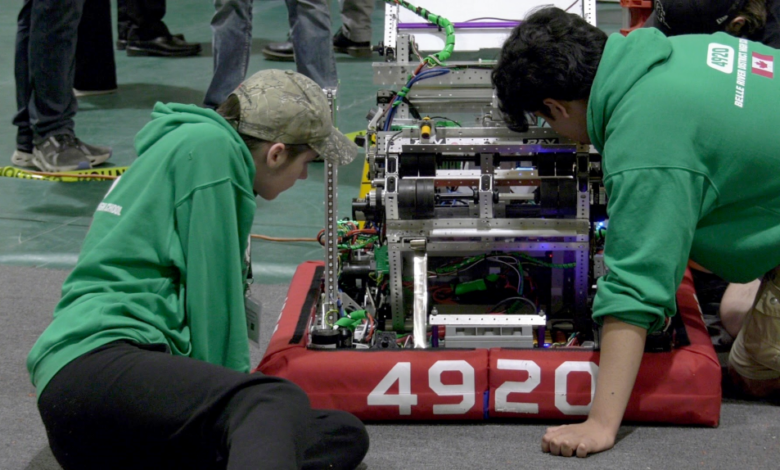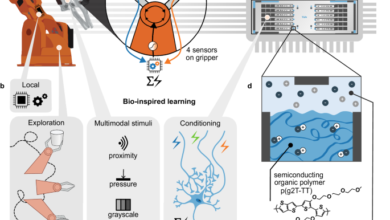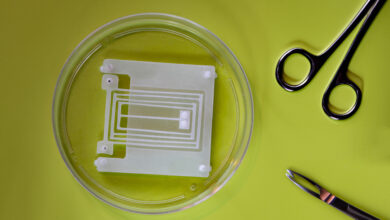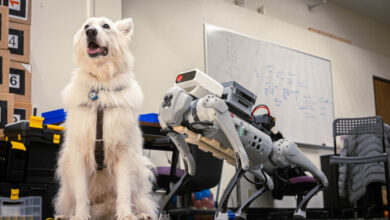Robotics Showcase at St. Clair College

As students across Windsor-Essex received a close-up look at robots designed by high school teams, teachers received an education of their own on ways to better incorporate robotics, coding, and STEM into their classrooms.
“With emerging technologies, with AI and with robotics and the high-needs for students to be able to problem-solve there, I can just imagine there’s going to be more and more of a push,” said Justin St. Pierre. “As educators, we’re trying to learn as we’re exploring these new fields and these new technologies.”
That journey of exploration took place Wednesday at St. Clair College’s south campus, as high school students and elementary teachers were invited for the inaugural Robotics Showcase, presented by the Greater Essex County District School Board and FIRST Robotics.
St. Pierre works with the GECDSB as a teacher consultant for Ontario’s Specialist High Skills Major (SHSM) initiative.
Most high schools provide SHSM programs, which sees eight or nine courses, bundled around a specific career field such as construction, manufacturing, or auto service.
According to St. Pierre, students need to be equipped with coding and STEM skills earlier in their lives through the introduction of more advanced equipment.
Today’s classrooms are starting to shift toward becoming classrooms of the future, he added.
“Before, you’d just have blades and welding machines. Now, we are seeing more CNC machines…we’re seeing 3D printers. These types of technologies really allow our students to solve problems, prototype, and really get prepared for that next step in their career,” said St. Pierre.
According to 10-year-old Camren Ferriss, laptops, phones, and iPads have become commonplace in today’s classroom.
“We’re able to access Google Translate for French class and a little bit of Duolingo,” said Ferriss.
Optimotive Technologies CEO Scott Fairley, who was at the Robotics Showcase promoting his company to students, said it’s imperative for today’s students to immerse themselves into technology while in the classroom.
“Everybody that’s at this event here today from the schools is going to be in a world surrounded by robots, AI, and automation,” said Fairley. “Giving them unfettered access to these new technologies is going to be critical for them to adopt and be built into the workforce.”
The workforce, particularly in Essex County, is rapidly becoming reliant on automation machinery for sectors such as greenhouses, manufacturing, logistics, and warehousing, according to St. Clair College’s dean of engineering technologies, skilled trades and apprenticeships.
“When you look at the automation component, and robotics in general, it touches every industry,” said Lido Zuccato. “It’s changing what people need to be trained in. You’re going to be training people how to program and maintain these robots, as opposed to actually doing the physical labour of what the robots are doing. It’s just the way the industry is going and we need to be ahead of it.”
Ironically, it’s a representative with FIRST Robotics Competition (FRC) who has a different view on what it will take for classrooms to transform. According to William Neal, FRC competition program manager, more technology will only do so much.
Instead, he said it will require a shift in how young people view their role as a student.
“We’re starting to see it in the classrooms. The mindset is shifting, such that there’s not a teacher dispensing knowledge at the front of the classroom. Rather, the entire class is full of teachers and learners,” said Neal. “By making this mindset shift, you’re able to accelerate the learning like never before imagined.”
“I’ve seen it in my own classroom. We plan the lessons with the students. They gain capability and academic independence and are able to share in each other’s learning. They’re not always coming to the teacher,” said Neal.



